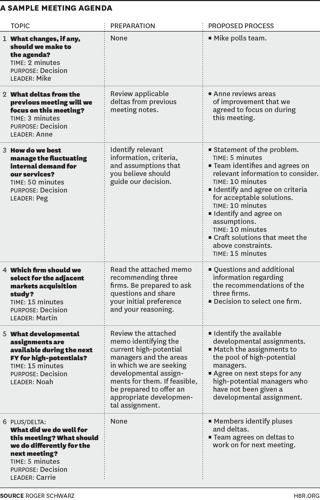
Have you ever been in a meeting that veered off course and shifted to family, sports, or even movie recommendations? Most meetings appear harmless, they start with “we need to discuss X.” However, five minutes into many meetings, a team can end up looking around wondering who actually called the meeting and if it’s supposed to go 30 minutes or 60 or?
Of course, we can’t just abandon meetings, even though we’ve all thought, “I’ll be alright if I never have to attend a meeting ever again.” Meetings are critical to a team’s success, meetings put us on the same page and organize our efforts and workflows. So how can we ensure that meetings are effective and beneficial to all attendees?
The very best agenda I’ve come across was recommended to me by a friend and colleague I respect greatly. It’s the agenda put together by Roger Schwarz and available on the Harvard Business Review blog.
Here’s what I love about the agenda template Schwarz put together:
-
Makes Topics Manageable: It breaks large discussions into manageable topics, on top of that, the agenda even starts with a review of the agenda. It doesn’t simply say, we’re talking about “Project Y” - the agenda breaks down the different areas that need to be discussed about “Project Y.”
-
Clear assignments: leaders for each topic are assigned prior to the meeting, the expectations for prep work are explained, and the process details further assignments as needed.
-
Prep Work is Laid Out: Each and every topic has a space where organizers can explain the expectations members have in order to properly prepare themselves for a meaningful discussion.
-
Details! Each topic is thought out ahead of time and a time limit, purpose, and leader is assigned. This helps the entire meeting stay on track, and allows participants to understand the constraints so they are less likely to wander in their train of thought.
-
(Timed) Plan of Attack: Topic rows are concluded with a “proposed process” area where each step can be laid out and even given a time limit.
-
Review: Each meeting ends with a short evaluation, which enables the team to become more effective for the next go around.
Have you ever left a meeting thinking, “Wow, that was actually very productive”? Well, prepare yourself. A well-planned and articulated agenda does three great things:
-
It shows respect for your colleagues, your boss, and your organization. You are showing that you care enough about the topic and their insight to prepare in advance.
-
It doesn’t waste time or money. It provides a track for the train to stay on. If you have a team of five people, all making $15/hour, that meeting costs the organization $75/hour. Be judicious about the subtopics and the people that need to be at the meeting.
-
It removes any question marks. Participants know exactly what to expect and how to prepare. Clarity is the name of the game.
My recommendation? Download the sample agenda at HBR and start plugging away! Let team members know that you’ll be sending out an agenda prior to the next meeting.
Your Turn! Do you have any tips for creating and implementing an effective agenda? What has worked best for you?
Want to receive notifications about more content like this? Subscribe to this blog, Technology & Your Ministry.

























